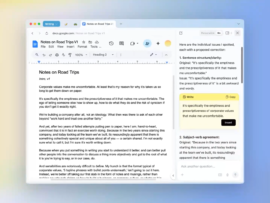
Dia, the AI-powered browser from The Browser Company that debuted in beta a few months ago, has introduced a $20-per-month Pro plan aimed at heavy users. Created by The Browser Company, the startup behind the innovative Arc browser, Dia seeks to reclaim attention from rivals such as chatbots like ChatGPT.
The idea is that AI is baked into the browser’s URL bar so users never need to visit third-party sites or apps to access a chatbot. The Browser Company wants the browser to have an awareness of the user’s existing tabs and internet history, so they don’t need to keep cutting and pasting information in as prompts.
Dia is built on Chromium, an open-source web browser project developed by Google that underpins browsers like Chrome and Edge, so its interface should feel familiar enough that users can dive straight in. However, the beta remains available only on macOS, and only to existing Arc members or individuals they’ve invited.
Details on the new Pro plan
The $20 Pro plan gives users access to Dia’s AI chat and Skills without the frequency caps imposed on free accounts. The company describes this as “unlimited,” but its Terms of Use state that activity can be restricted if deemed excessive, without defining specific limits.
The paid tier was expected. The Browser Company’s CEO Josh Miller told The New York Times in July that subscriptions were coming, with pricing based on AI usage. He added that Dia would remain free for those who use its AI tool only “a few times a week.”
Neither Miller’s comment nor the Pro plan launch clarifies what “a few times a week” means or how the company determines heavy use.
How to use the Dia browser
URL bar
Dia’s URL bar functions normally, but it can also serve as a chatbot input field. In addition to performing usual tasks such as summarising text files, the built-in AI can answer questions about the content of all open tabs. A sidebar also contains a chatbot that can assist with interactions in the active webpage.
History feature
If a user opts into Dia’s History feature, the browser’s AI can learn from and tailor its responses based on the past seven days of browsing history. This context could be used to deliver personalised recommendations when the user expresses interest in purchasing a product or to adapt its responses to match their preferred writing style.
Skills
In addition, Dia users can create AI-powered browser shortcuts known as Skills simply by asking the chatbot. Two Skills come pre-installed by default: Write, which drafts text in the user’s voice, and Code, which assists with programming based on the user’s preferences. Users can create custom Skills that will, for example, apply a distraction-free reading layout, autofill web forms using information from their CV, or remove sidebars from social media feeds.
Availability of these AI features now depends on the user’s subscription tier.
Dia ensures security through how it stores and processes data
Some of Dia’s features resemble Recall, Microsoft’s ill-fated AI tool for Copilot+ PCs, which captured snapshots of user activity to make history searches easier. Recall faced backlash after researchers showed attackers could access the database and view sensitive information.
The Browser Company is prioritisingDia’s security, with a dedicated team and planned bug bounties and audits. Hursh Agrawal, the company’s co-founder, told The Verge that all user data is stored locally on the device and encrypted. Data sent to an external server for processing remains there only for milliseconds before being deleted. The goal is to eventually complete all processing on-device.
Other browser makers are reluctant to assume the security risks. Vivaldi, for instance, has opposed integrating AI features into its browser, citing concerns over privacy, as well as the potential for plagiarism and misinformation.
Dia’s not the only browser to integrate AI
Miller calls Dia a step toward an “Internet Computer,” where traditional web browsing and AI-powered tools merge. He believes he’s spotted an opportunity to build a next-generation browser while AI reshapes how people interact with the internet.
“Traditional browsers, as we know them, will die,” Miller said in a blog post last month. “We’re getting out of the candle business. You should too.”
The company is not alone in pursuing this idea. Microsoft has built its Copilot AI assistant into Edge, while Opera’s Neon, its “agentic” browser released last month, can build custom mini-applications at users’ request, similar to Dia’s Skills.
Why Arc was put into maintenance mode
In May, The Browser Company announced that its first browser Arc was moving to maintenance mode. While it is not shutting down, no new features will be added.
In a lengthy and candid letter to Arc users, Miller explained the reasoning behind the move. He admitted that while Arc had a loyal following, it ultimately fell short of the company’s original vision.
“From the outside, this pivot might look abrupt. Arc had real momentum. People loved it. But inside, the decision was slower and more deliberate than it may seem,” he wrote in a blog post.
The team considered selling or open-sourcing Arc, but it runs on a proprietary system called ADK (Arc Development Kit), which also underpins Dia. Open-sourcing Arc would mean exposing ADK, something the company is not yet ready to do.
“While we’d love to open-source Arc someday, we can’t do that meaningfully without also open-sourcing ADK,” Miller explained.
Arc didn’t work for the masses
Arc earned praise for its unique design — including spaces, live folders, and a sleek design made it a favourite among power users. But Miller acknowledged that most people found it too complex.
“For most people, Arc was simply too different, with too many new things to learn, for too little reward,” Miller wrote.
Arc’s experimental features generated interest, but few users struggled with them. According to internal data shared in the letter, only 5.52% of daily users used more than one “Space” (a key feature), only 4.17% used Live Folders (including GitHub Live Folders), and just 0.4% used the Calendar Preview on Hover.
GPT-5 is here. OpenAI’s latest multimodal model can create complete software programs on request, expanding its range of practical uses.
Source of Article



